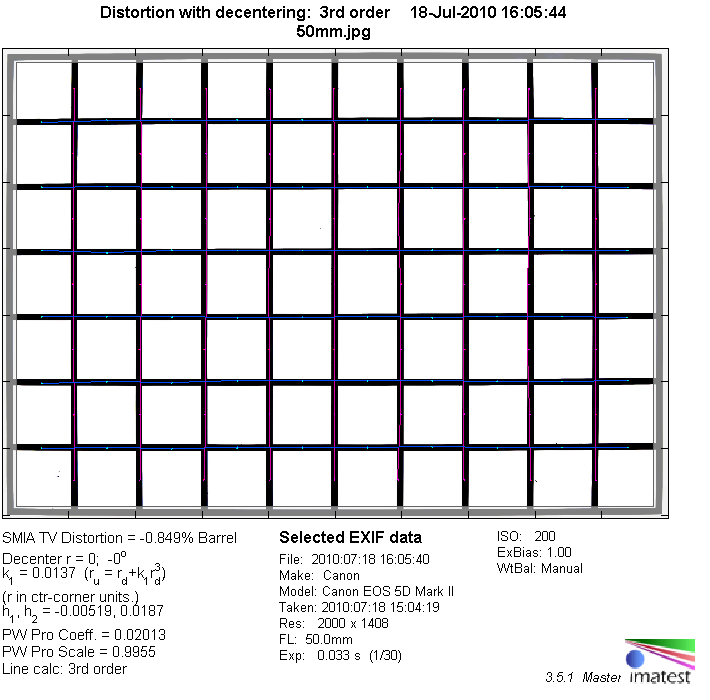|
Zeiss Makro-Planar T* 50mm f/2 ZF (ZE) (on Canon EOS) - Lab Test / Review - Analysis |
|
Lens Reviews -
Canon EOS (Full Format)
|
|
Page 2 of 2

Distortion
The Makro-Planar produces only a slight degree (~0.8%) of barrel distortion which isn't really
field relevant anymore.

The chart above has a real-world size of about 120x80cm.
Vignetting
The Makro-Planar may not be as fast as a conventional standard prime lens but it suffers
from a similar amount of light falloff at max. aperture (2.2EV). The vignetting is still
visible at f/2.8 and you've to stop down to f/4 in order to resolve the issue.

MTF (resolution)
Macro lenses tend to be great performers and the Zeiss is no exception
to the rule. At wide-open aperture the lens is already extremely sharp in the
center whereas the borders/corner are a little softer but still in very good territory (just).
The quality increases gradually the more you stop down and the global peak is reached
around f/5.6 with an excellent center-to-edge quality. Diffraction is the limiting factor beyond
f/8 so even Zeiss cannot fool physics. However, the results are still usable even at f/22.
Please note that the MTF results are not directly comparable across the different systems!
Below is a simplified summary of the formal findings. The chart shows line widths per picture height (LW/PH) which can be taken as a measure for sharpness.
If you want to know more about the MTF50 figures you may check out the corresponding Imatest Explanations
Chromatic Aberrations (CAs)
The Makro-Planar produces a very minimal amount of lateral CAs (color shadows at harsh contrast
transitions). This is not field relevant and an excellent performance in this category.

Bokeh
The quality of the bokeh (out-of-focus blur) is naturally a major aspect for a macro lens. The Zeiss lens
does a very good job here. The inner zone of out-of-focus highlights is very evenly rendered. However, the
discs deteriorates to a "cat's eye" shape at large apertures which is less pleasing than the circular
shape (which is achieved at smaller apertures). The blur in the focus transition zones is very smooth.

Bokeh Fringing / Longitudinal Chromatic Aberrations (LoCA)
There's a some bokeh fringing (greenish/purple halos in the focus transition zone) at f/2 but it's not overly disturbing.
The issue is somewhat resolved at f/2.8 and not really relevant anymore from f/4 onwards.
|
Move the mouse cursor over the f-stop marks below to observe the respective LoCAs
|
| f/2 |
f/2.8 |
f/4 |
|

|
Verdict
Just like the rest of the Zeiss Z-series the Makro-Planar 50mm f/2 is not a
lens for mainstream users due to the lack of AF. However, to put things into
perspective - AF is not a killer feature for macro lens anyway but then you may
also argue that its very large max. aperture may be sufficient to substitute a
conventional 50mm lens.
Quality-wise it's an impressive lens offering a very high resolution till
diffraction takes its toll. Lateral CAs are basically non-existent and
the little amount of barrel distortion is not field relevant.
At f/2 there's some vignetting which can be disturbing in some scenes so
you should either stop down or resolve the issue during image
post-processing. The bokeh (out-of-focus blur) is generally very smooth and
buttery.
A comparison to competing macro lenses is a little difficult. On the upside the
Zeiss is a full stop faster than but on the other hand the max. object magnification
is "just" 1:2 which may be a somewhat limiting factor for macro enthusiasts (that's
also true for the Canon EF 50mm f/2.5 macro though). So you gain and loose a little in
terms of flexibility. The price tag is comparatively steep at around 1100-1200€/US$
so you really have to have an itch for such classic lenses.
|